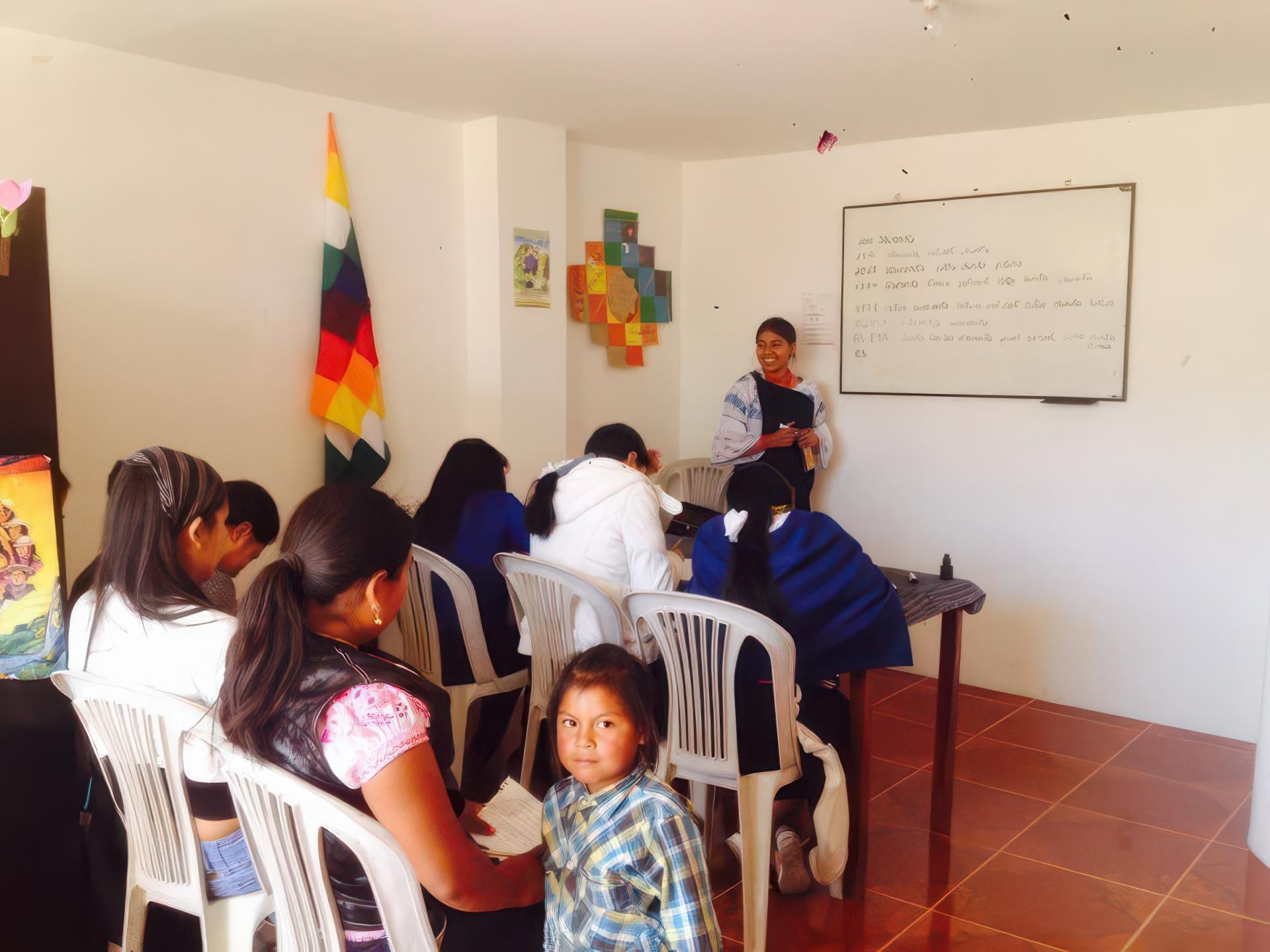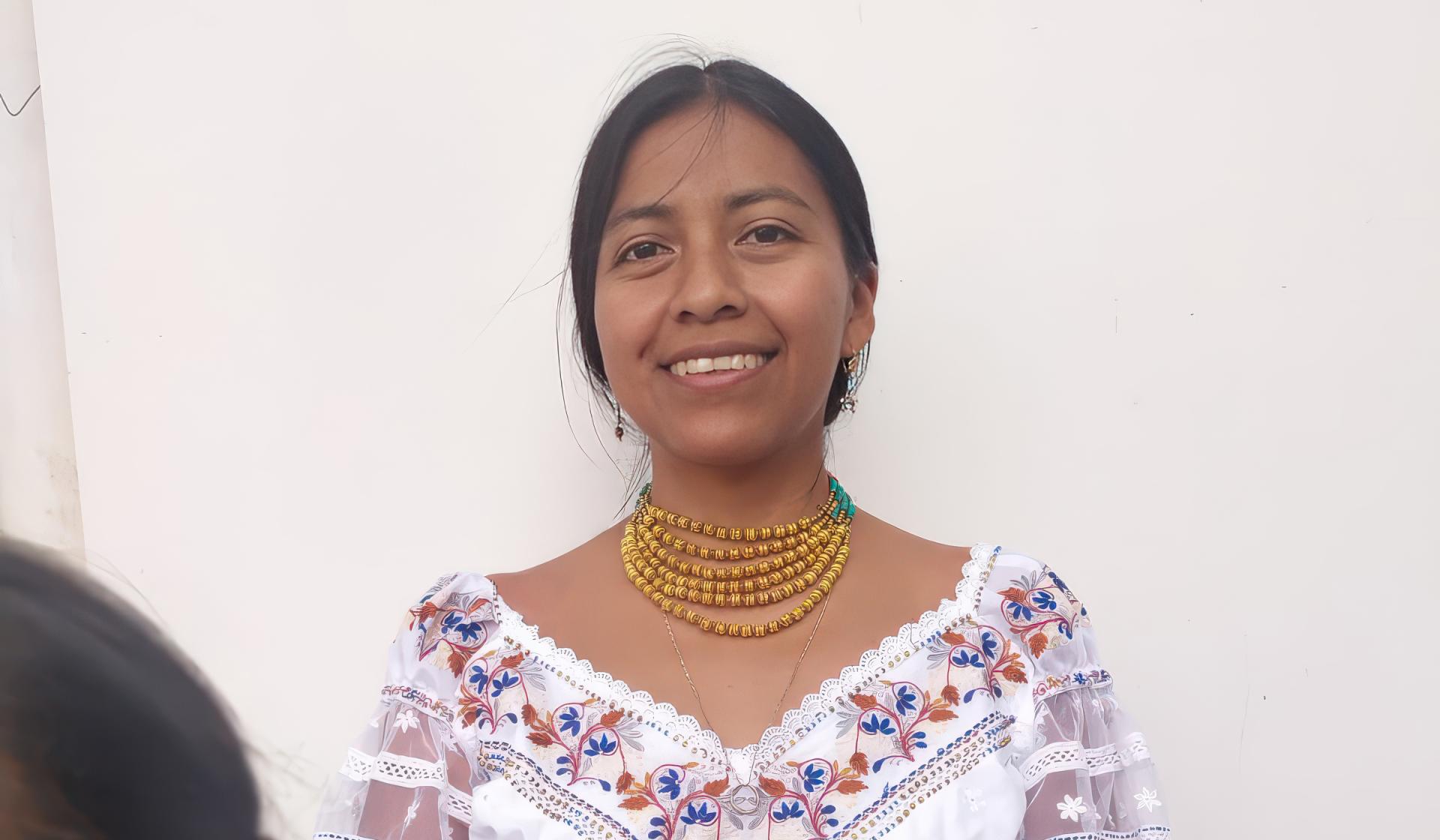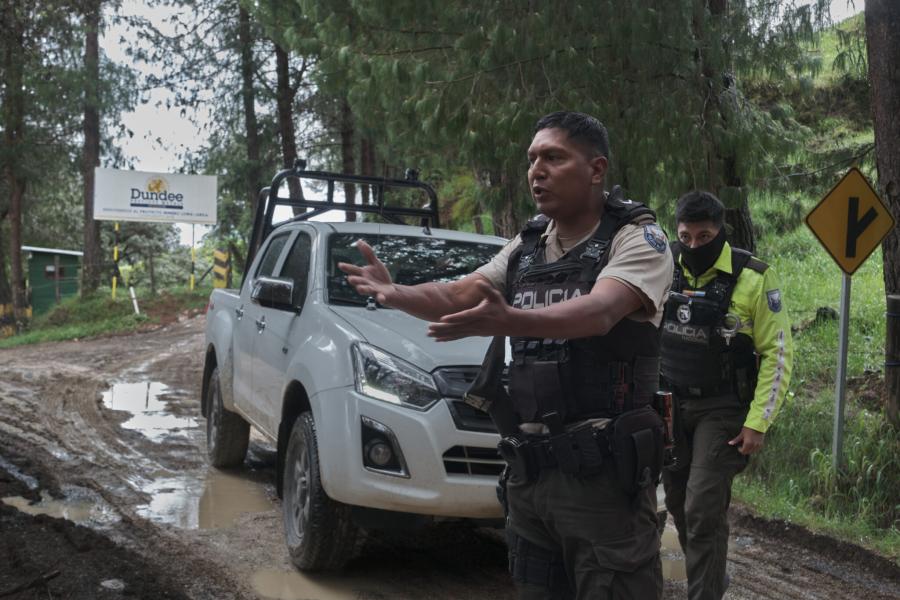
Sisa Anrango (Kichwa de Otavalo) es una mujer Kichwa de la comunidad Puñaru/Punyaro de Otavalo, Ecuador. Actualmente trabaja en línea como profesora de kichwa especializada en la creación de espacios de aprendizaje kichwa totalmente inmersivos para todos los niveles. En 2018 recibió una beca para viajar al País Vasco, España, y participar en un posgrado sobre estrategias de revitalización lingüística y metodología para la enseñanza de segundas lenguas en la Universidad de Mondragón. Aparte de sus funciones como profesora y activista, Anrango se dedica a ser madre, una identidad que ha reforzado sus esfuerzos por revitalizar su cultura. Durante la última década, Anrango se ha dedicado a investigar su cultura, redescubrir la historia de las creencias y tradiciones de su familia y replicarla en su vida.
Anrango recuerda que en las calles de Otavalo se encontraba con personas mayores que a veces le pedían ayuda en Kichwa. “Recuerdo que me sentía triste y avergonzada por no poder ayudarles, ya que no les entendía”, expresa. “No conocí a mis abuelos y siempre sentí que me faltaban en mi vida, así que ver a estos ancianos en la calle y no poder ayudarles me conmovió porque no podía hablar nuestro idioma”. Aunque los padres de Anrango la vistieron con ropa tradicional desde que nació, de niña sólo se comunicaban con ella en español, algo que más tarde llegaría a cuestionar.
Anrango sufrió depresión durante gran parte de su juventud, hasta que un curso de Kichwa llamó su atención. Por aquel entonces, ayudaba a su madre con su pequeño negocio de comercio y pudo matricularse con el dinero que ganaba. “En el curso se habló de la importancia de mantener viva nuestra cultura y nuestra lengua. Después de años de sufrir un racismo duro y horrible, me conmovió oír continuamente lo hermosa que es nuestra cultura y el valor de nuestra gente”, dice. El mismo año en que Anrango comenzó sus estudios de Kichwa, vendría la alumna más importante de su vida, su hija, cuyo nacimiento la llevaría a reflexionar aún más sobre la lengua de su pueblo. Pensó en sus padres y en cómo “debieron reír, llorar, enfadarse y amar en kichwa. Quería que mi hija viviera con el idioma kichwa, que conectara reconectara y estuviera orgullosa de su identidad. Quería que mi hija recibiera una educación en kichwa y se sintiera querida en la lengua de sus antepasados”, afirma.
 Sisa Anrango impartiendo su primera clase de kichwa en 2015.
Sisa Anrango impartiendo su primera clase de kichwa en 2015.
Seis meses después del nacimiento de su hija, Anrango se separó de su pareja. Ahora era madre soltera y desempleada, Anrango no estaba segura de lo que vendría después. Pensó en lo que la hacía feliz: sus cursos de kichwa. Había memorizado toda la gramática y, aunque aún no hablaba del todo la lengua, se sentía lo bastante segura como para impartir un curso introductorio en cuanto se le presentara la oportunidad. Aunque no tenía muchos alumnos, le encantaba crear espacios de sanación colectiva en sus primeras clases, “recordándonos que nuestra identidad es valiosa porque la sociedad nos dice constantemente que todo lo Indígena es malo”. A través de estos cursos introductorios, Anrango seguiría aprendiendo más sobre su lengua. “Mi hija fue como un despertar. Cuanto más aprendía, más comprendía que todo lo que soy es porque mis abuelos y bisabuelos eran así".
En 2018, Anrango tomó un curso sobre nuevas metodologías para la enseñanza de lenguas secundarias, enfocado en crear espacios de inmersión total para que los estudiantes aprendieran a hablar Kichwa desde la primera clase. El cambio de sistemas de gramática y filosofía a uno más conversacional le hizo darse cuenta de algo: “La educación convencional es muy violenta con los estudiantes y esa violencia permeabiliza el proceso de aprendizaje, entonces cuando la gente quiere aprender algo nuevo más adelante en la vida, tiene mucho miedo de equivocarse, mucho miedo de hablar, sobre todo la gente que ha dejado sus estudios. La educación convencional tiene una dinámica de ridiculización, humillación y penalización de los errores. Con cada nuevo grupo tengo que darles la seguridad de que están en un espacio donde se pueden repetir las cosas, donde se pueden equivocar, donde no van a ser juzgados”. Aplicar esta nueva metodología requiere paciencia y recurrir a elementos visuales y gestos físicos. Ya no se traduce palabra por palabra, y la concentración que se exige a los alumnos es mayor. “Salen de su zona de confort en la primera clase, lo que es clave para aprender la lengua y practicarla con otros hablantes de kichwa”, afirma Anrango, añadiendo que, según su propia experiencia como estudiante de este idioma, es mejor para el aprendizaje individual y para la vitalidad de la lengua practicar el habla cotidiana que conocer todas las reglas gramaticales. Fue en esta segunda etapa de su carrera docente cuando Anrango regresó a casa.

Sisa Anrango.
Cumpliendo uno de sus viejos sueños, Anrango volvió a vivir permanentemente en su comunidad en 2021. Desde entonces, se ha dedicado “a volver a la tierra y continuar una vida más íntima y cuidadosa con la naturaleza.” Tras haber trabajado con adultos durante la mayor parte de su carrera docente, el nuevo objetivo de Anrango es enseñar a niños. Sin embargo, su objetivo no está exento de retos. Un obstáculo es la percepción general de la lengua Kichwa en el pueblo. “Trabajar con mi comunidad es complejo. La idea de que el Kichwa es una lengua atrasada de tiempos antiguos es muy fuerte”, afirma. El legado del colonialismo ha devaluadas las lenguas Indígenas en Ecuador, y el público en general no considera que el Kichwa sea económicamente beneficioso para su futuro. Anrango se esfuerza por cambiar esta mentalidad centrándose en la autoestima y el desarrollo positivo de la identidad entre los jóvenes. “Uno de los logros es que al menos la mitad de las reuniones comunitarias se celebran en kichwa. También tengo tres proyectos en marcha que necesitan financiación. Uno de ellos es una colección de poemas en kichwa para niños de tres años sobre la conexión con la naturaleza y los animales, que aún necesita ser ilustrada e impresa”.
Para Anrango, encontrar un equilibrio entre dedicarse a su pasión, dedicar tiempo a su familia y ganarse la vida dignamente es importante. En un país donde aprender inglés se considera más valioso que aprender kichwa, puede ser difícil que los profesores de esta lengua reciban una buena remuneración. “Creo que todas las personas que se atreven a enseñar su lengua materna lo hacen con la voluntad más noble del mundo, dedicando mucho de su tiempo, pero también tenemos familias que cuidar y costos de vida que pagar. Para que estos espacios educativos sean constantes y duraderos, debe existir una remuneración justa y equitativa por el trabajo y el esfuerzo de los profesores de idiomas. La sociedad deposita mucha responsabilidad en nosotros como Pueblos Indígenas. Si se pierde la lengua, es culpa nuestra; si los jóvenes dejan de llevar nuestra ropa, es culpa nuestra; si la gente decide abandonar su identidad Indígena, es culpa nuestra. Todo es nuestro deber y nuestra responsabilidad», comenta Anrango.
“Cuando aprendí kichwa, sentí que también estaba completando algo que me faltaba. Recuerdo que hubo un momento en mi juventud en el que me enfadé mucho con mi padre y mi madre, pensando que eran tan débiles que se dejaron influir por la sociedad y no me enseñaron kichwa cuando era pequeña”, dice Anrango. “Reflexionando sobre esa transición con mis padres, quizá podría haberlo hecho con más paciencia y más cariño. A los jóvenes que están aprendiendo kichwa, deben tener mucha paciencia y fe en el aprendizaje de la lengua de sus antepasados y aprovechen todos los recursos disponibles. A los que tienen hablantes de kichwa en sus familias, anímenlos a hablar en este idioma con ustedes. Decoren sus entornos familiares con expresiones en kichwa. Saluden y muestren afecto a sus familiares en este idioma. Ese era el sueño de nuestros abuelos, que un día por fin fuéramos libres y pudiéramos existir como somos sin ser violentados. Vivir en kichwa con nuestras familias, amigos y vecinos es disfrutar por fin de esa libertad por la que tanto hemos luchado. Tenemos que reconocer esos logros y aprovechar esta libertad que ahora tenemos”.
Para saber más sobre los cursos de Kichwa de Sisa Anrango y apoyar sus proyectos, visite linktr.ee/SisaAnrango.
Foto superior: Sisa Anrango (centro derecha) con su hija y cinco ancianos kichwas después del ritual Shutichiy en la cascada de Taxopampa.


